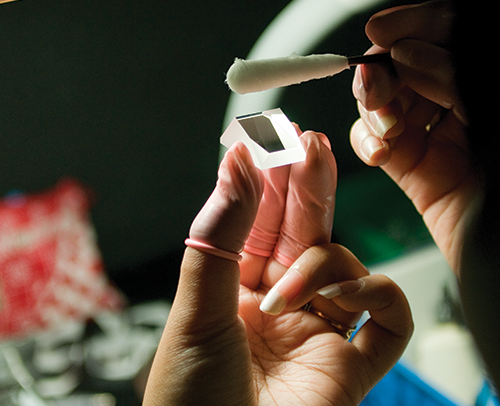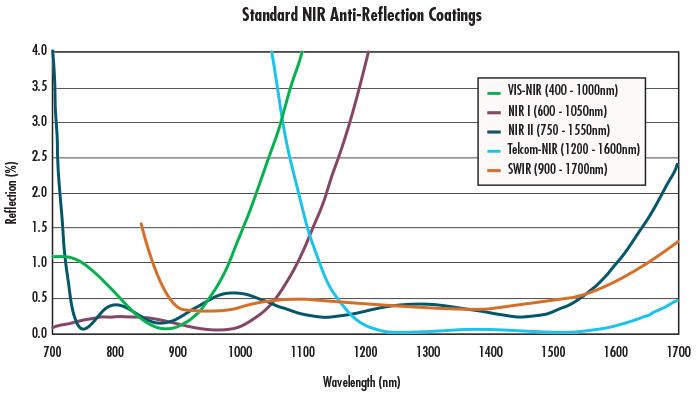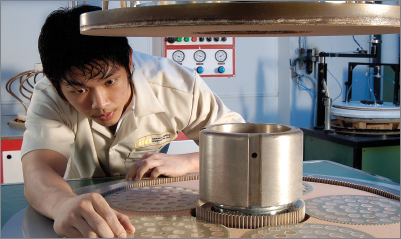Understanding Optical Windows
Optical Windows are flat, optically transparent plates that are typically designed to maximize transmission in a specified wavelength range, while minimizing reflection and absorption. They are often used to protect optical systems and electronic sensors from an outside environment. Because windows introduce no optical power into a system, windows should be selected based on the material transmission properties, optical surface specifications, and the mechanical properties that match your application.
Material Properties
Material properties including the transmission, refractive index, and hardness of the window substrate can be critical for deciding which window is the best choice for your application. The figure below highlights the transmission regions of the different materials Edmund Optics® offers as windows.

Figure 1: Transmission regions for Edmund Optics® window substrates.
Several other key properties for selecting the appropriate window for your application include the index of refraction, Abbe number, density, and coefficient of thermal expansion. The selection guide below lists the optical, mechanical, and thermal properties of our available window substrates as well as their size and thickness ranges.
| Windows Selection Guide | ||||||||
| Material | Index of Refraction $ \small{\left(n_d \right)} $ | Abbe Number $ \small{\left(v_d \right)} $ | Density $\small{\left[ \tfrac{\text{g}}{\text{cm}^3}\right]}$ | Coefficient of Thermal Expansion $ \small{ \left[ \frac{\text{μm}}{ \text{m}^{\text{o}} \text{C}} \right]} $ | Softening Temp $ \small{\left[ ^{\text{o}} \text{C} \right]} $ | Knoop Hardness | Size Range | Thickness Range |
| Acrylic (PMMA) | 1.49 | 58.0 | 1.18 | 72 | 115 | 18 | 25.4 - 203.2 x 254mm | 1.52mm |
| B270 | 1.523 | 58.5 | 2.55 | 8.2 | 533 | 542 | 5 - 200mm | 1.0 - 4.0mm |
| Barium Fluoride (BaF2) | 1.48 | 81.61 | 4.89 | 18.1 | 800 | 82 | 5 - 50mm | 1.0 - 3.0mm |
| BOROFLOAT® | 1.472 | 65.7 | 2.20 | 3.25 | 820 | 480 | 5 - 200mm | 1.1 - 6.5mm |
| Calcium Fluoride (CaF2) | 1.434 | 95.1 | 3.18 | 18.85 | 800 | 158.3 | 5 - 125mm | 1.0 - 12.7mm |
| Diamond (C) | 2.38 | 55.3 | 3.51 | 37 | - | 7000 | 5 x 5 - 10mm | 0.5 - 0.7mm |
| Germanium (Ge) | 4.003 | N/A | 5.33 | 6.1 | 936 | 780 | 5 - 150mm | 1.0 - 8.0mm |
| Gorilla® Glass | 1.509 | N/A | 2.44 | 7.88 | 843 | 5100 | 5 - 500 x 500mm | 0.4 - 2.0mm |
| Lithium Fluoride (LiF) | 1.392 | 97.29 | 2.64 | 37 | 600 | 102 | 5 - 50mm | 1.0 - 3.0mm |
| Magnesium Fluoride (MgF2) | 1.413 | 106.2 | 3.18 | 13.7 | 1255 | 415 | 5 - 75mm | 1.0 - 6.0mm |
| N-BK7 | 1.517 | 64.2 | 2.46 | 7.1 | 557 | 610 | 2 - 200mm | 0.2 - 10.0mm |
| Polycarbonate | 1.585 | 34.0 | 1.21 | 65 | 145 | - | 25.4 - 203.2 x 254mm | 1.52mm |
| Potassium Bromide (KBr) | 1.527 | 33.6 | 2.75 | 43 | 730 | 7 | 13 - 50mm | 1.0 - 5.0mm |
| Sapphire | 1.768 | 72.2 | 3.97 | 5.3 | 2000 | 2200 | 1 - 150mm | 0.4 - 5.0mm |
| Silicon (Si) | 3.422 | N/A | 2.33 | 2.55 | 1500 | 1150 | 10 - 76.2mm | 1.0 - 6.0mm |
| Sodium Chloride (NaCl) | 1.491 | 42.9 | 2.17 | 44 | 801 | 18.2 | 13 - 50mm | 1.0 - 5.0mm |
| Thallium Bromoiodide (KRS-5) | 2.615 | N/A | 7.37 | 6.0 | - | 40.2 | 12.7 - 50.8mm | 1.0 - 6.0mm |
| Thermoset ADC (CR-39®) | 1.501 | 59.2 | 1.32 | - | - | - | 5.0 - 254 x 304.8mm | 1.5mm |
| UV Fused Silica | 1.458 | 67.80 | 2.20 | 0.55 | 1000 | 500 | 2 - 200mm | 1.0 - 5.0mm |
| Zinc Selenide (ZnSe) | 2.403 | N/A | 5.27 | 7.1 | 250 | 120 | 5 - 127mm | 1.0 - 8.0mm |
| Zinc Sulfide (ZnS) | 2.631 | N/A | 5.27 | 7.6 | 1525 | 120 | 12.5 - 76.2mm | 1.0 - 8.0mm |
Refractive Index
The index of refraction is the ratio of the speed of light in a vacuum to the speed of light in an optical medium, which describes how light slows down as it passes through the material. The refractive index for optical glasses $ \small{\left( n_d \right)} $ is specified at the Helium d-line wavelength of 587.6nm. Glasses with a low index of refraction are commonly referred to as "crowns" and glasses with a high index of refraction are referred to as "flints."
Abbe Number
The Abbe number $ \small{\left( v_d \right)} $ describes the material’s dispersion, or variation of the refractive index with wavelength. It is defined as $ \frac{\left( n_d -1 \right)}{\left( n_F - n_C \right)} $ where $ \small{n_F} $ and $ \small{n_C} $ are the refractive indices at 486.1nm (Hydrogen f-line) and 656.3nm (Hydrogen c-line), respectively. Low Abbe numbers indicates high dispersion. Crown glasses tend to have higher Abbe numbers than flints.
Density
The density of a glass is important to consider because it helps determine the weight of the optical assembly, which is critical for weight-sensitive applications. Generally, the refractive index of a glass increases as the density increases. However, the relationship between refractive index and density is not linear.
Coefficient of Thermal Expansion
The coefficient of thermal expansion describes how the size of the glass will change with changes in temperature. This property is a key factor in applications involving extreme temperatures and quick temperature differentials.
Knoop Hardness
The Knoop hardness of a glass is a measure of its resistance to indentation. It is determined by using a fixed force with a given indenter and measuring the depth of the resulting indentation. The smaller the indentation, the higher the Knoop hardness. In general, materials with a high Knoop hardness are less brittle and can withstand greater pressure differentials than materials with a smaller Knoop hardness.
Optical Surface Specifications
The surface specifications of optical windows affect the optical performance and must be considered when selecting or specifying a window. It is important to make sure your optical window has the appropriate specifications with respect to tightness to meet your application requirements, but over-tolerancing the window will unnecessarily increase the cost.
Surface Quality
The surface quality of an optical window is an evaluation of surface imperfections that may be caused during manufacturing or handling. These defects typically cause small reductions in throughput and small increases in scattered light, which have little to no adverse effect on the overall system performance in most imaging or light gathering applications. However, some surfaces are more sensitive to these defects, such as surfaces at image planes, because surface defects are in focus. Windows with high power levels are also sensitive to surface defects because they can cause increased absorption of energy and damage the window.
Surface quality is often described by the scratch-dig specification in the U.S. Standard MIL-PRF-13830B. The scratch designation is determined by comparing the scratches on a surface to a set of standard scratches under controlled lighting conditions. This is not a direct measurement of the scratch dimensions themselves. On the other hand, the dig designation directly relates to the size of the dig. The dig designation is calculated by taking the diameter of the dig in microns and dividing it by 10.

Figure 2: Surface quality inspection.
| Scratch-Dig | Description |
| 80-50 or 60-40 | These are the most commonly used surface quality specifications for commercial grade applications and cases where surface quality is not critical. Windows for imaging systems typically fall in this category. These provide the most cost-effective window options. |
| 40-20 | Used for precision applications where surface quality is important. This is a common specification for low to medium powered laser systems and smaller optics. There is some premium over lower surface-quality windows. |
| 20-10 or 10-5 | These specifications are used almost exclusively for high power laser systems and very high precision systems where surface quality is critical. There is typically a significant cost premium associated with these surface quality specifications. |
Table 2: This table shows scratch-dig specifications needed for a variety of applications.
To learn more about scratch-dig specifications, visit our Understanding Surface Quality Specifications based on U.S. Standard MIL-PRF-13830B application note.
Surface Flatness
Surface flatness measures the deviation of the window from a perfectly flat surface. The surface flatness of a test piece can be measured using an optical flat, which is a highly precise flat reference surface. When the surface of the test window is placed against the optical flat, fringes appear whose shape dictates the surface flatness of the window under inspection. The window’s surface is at least as flat as the reference flat if the fringes are evenly spaced, straight, and parallel. If the fringes are curved, the flatness error is indicated by the number of fringes between two imaginary lines: one tangent to the center of a fringe and one through the ends of that same fringe. Deviations in flatness are typically measured in values of waves (λ), or multiples of the testing light source’s wavelength. Every fringe corresponds to half of a wave. 1λ flatness can be used for typical applications, but high precision applications such as high power laser systems require flatness values down to λ/20.
Figure 3: Diagram demonstrating how an optical flat works.
| Surface Flatness | Description |
| ≥1λ | Commonly used for commercial grade applications and in cases where surface flatness is not critical. ≥1λ surface flatness is the most cost-effective window option. |
| λ/4 | Used for precision applications where surface quality is important. This is a common specification for low to medium powered laser systems and smaller optics. There is some premium over lower surface-quality windows. |
| ≤λ/10 | Used for high power laser systems and highly precise imaging systems. There is typically a significant cost premium associated with surface flatness ≤λ/10. |
Table 3: This table shows surface flatness specifications needed for varying applications.
Surface flatness is an increasingly important when using a window at a viewing angle besides normal incidence. To learn more about surface quality, surface flatness, and other surface specifications, visit our Understanding Optical Specifications application note.
Transmitted Wavefront Error
Surface errors, refractive index inhomogeneity, and stress on the window can induce transmitted wavefront errors. This distortion of the transmitted wavefront causes degradation of image quality in image-forming systems and other performance losses in non-imaging systems. Transmitted wavefront error can be reduced by properly mounting the window and avoiding putting unnecessary stress on it. Transmitted wavefront error, along with surface flatness, describes the overall quality and surface characteristics of the window. To learn more about different types of wavefront errors, or optical aberrations, visit our Comparison of Optical Aberrations application note.
Anti-Reflection (AR) Coatings
Anti-reflection (AR) coatings are often put on optical windows to maximize transmission in the desired wavelength range. Edmund Optics offers all TECHSPEC® windows with a variety of anti-reflection (AR) coating options that vastly improve the efficiency of the optic by increasing transmission, enhancing contrast, and eliminating ghost images. Most AR coatings are also very durable, with resistance to both physical and environmental damage. For these reasons, the vast majority of transmissive optics include some form of anti-reflection coating. When specifying an AR coating for your specific application, you must first be fully aware of the full spectral range of your system. While an AR coating can significantly improve the performance of an optical system, using the coating at wavelengths outside the design wavelength range could potentially decrease the performance of the system. The figure below shows the reflection plots of all the standard AR coatings we offer.


To learn more about AR coatings and find coating curves for our full selection of AR coatings, visit our Anti-Reflection Coatings application note.
Equivalent Glass Types
Many glass manufacturers offer the same material characteristics under different trade names and most have modified their products and processes to be ECO-friendly (free of lead and arsenic). Edmund Optics uses ECO-friendly glasses in many of our TECHSPEC® products, but this designation may not be reflected in the product descriptions. For products not manufactured by Edmund Optics, the inclusion of ECO glasses differs by manufacturer. Once an item has been switched to ECO glass, Non-ECO-friendly glasses will not be utilized again. Based on availability, we reserve the right to substitute an equivalent ECO glass in our production runs. The table below shows the glass equivalents for common optical glasses.
| Glass Material Equivalents | ||||
| Listed Glass Name | Glass Number | Schott Equivalent | Ohara Equivalent | CDGM Equivalent |
| N-BK7 | 517/642 | N-BK7 | S-BSL7 | H-K9L |
| N-K5 | 522/595 | N-K5 | S-NSL5 | H-K50 |
| N-PK51 | 529/770 | N-PK51 | – | – |
| N-SK11 | 564/608 | N-SK11 | S-BAL41 | H-BaK6 |
| N-BAK4 | 569/561 | N-BAK4 | S-BAL14 | H-BaK7 |
| N-BAK1 | 573/576 | N-BAK1 | S-BAL11 | H-BaK8 |
| N-SSK8 | 618/498 | N-SSK8 | S-BSM 28 | – |
| N-PSK53A | 618/634 | N-PSK53A | S-PHM52 | – |
| N-F2 | 620/364 | N-F2 | S-TIM 2 | H-F4 |
| S-BSM18 | 639/554 | – | S-BSM18 | H-ZK11 |
| N-SF2 | 648/338 | N-SF2 | S-TIM 22 | H-ZF1 |
| N-LAK22 | 651/559 | N-LAK22 | S-LAL54 | H-LaK10 |
| S-BAH11 | 667/483 | – | S-BAH 11 | H-ZBaF16 |
| N-BAF10 | 670/472 | N-BAF10 | S-BAH 10 | H-ZBaF52 |
| N-SF5 | 673/322 | N-SF5 | S-TIM 25 | H-ZF2 |
| N-SF8 | 689/312 | N-SF8 | S-TIM 28 | H-ZF10 |
| N-LAK14 | 697/554 | N-LAK14 | S-LAL14 | H-LAK51 |
| N-SF15 | 699/301 | N-SF15 | S-TIM35 | H-ZF11 |
| N-BASF64 | 704/394 | N-BASF64 | – | – |
| N-LAK8 | 713/538 | N-LAK8 | S-LAL8 | H-LAK7 |
| S-TIH18 | 722/293 | – | S-TIH18 | – |
| N-SF10 | 728/284 | N-SF10 | S-TIH10 | H-ZF4 |
| N-SF4 | 755/276 | N-SF4 | S-TIH4 | H-ZF6 |
| N-SF14 | 762/265 | N-SF14 | S-TIH14 | – |
| N-SF11 | 785/258 | N-SF11 | S-TIH11 | H-ZF13 |
| SF65A | 785/261 | SF65A | S-TIH23 | – |
| N-LASF45 | 800/350 | N-LASF45 | S-LAM66 | H-ZLaF66 |
| N-LASF44 | 803/464 | N-LASF44 | S-LAH65 | H-ZLaF50B |
| N-SF6 | 805/254 | N-SF6 | S-TIH 6 | H-ZF7LA |
| N-SF57 | 847/238 | N-SF57 | S-TIH53 | H-ZF52 |
| N-LASF9 | 850/322 | N-LASF9 | S-LAH71 | – |
| S-NPH2 | 923/189 | – | S-NPH2 | – |
| N-SF66 | 923/209 | N-SF66 | – | – |
Need a custom window?
With our global manufacturing capabilities we can make it for you.

- Sizes Ranging from 3 - 500mm with Thickness Starting at 0.2mm
- Dozens of Materials from Standard Glass Catalogs of Schott, Hoya, Ohara, and CDGM
- Infrared Materials Including Fluorides, Ge, Si, ZnS, and ZnSe
- Wide Variety of Anti-Reflection Coatings Including Broadband, Laser-Line, and ITO Conductive
- Quick-turn Coating Options on Off-the-Shelf Uncoated Substrates
- Through our Modified Stock Services
- Rapid Custom Sizing of all Float Glass Materials





























or view regional numbers
QUOTE TOOL
enter stock numbers to begin
Copyright 2023, Edmund Optics India Private Limited, #267, Greystone Building, Second Floor, 6th Cross Rd, Binnamangala, Stage 1, Indiranagar, Bengaluru, Karnataka, India 560038
California Consumer Privacy Acts (CCPA): Do Not Sell or Share My Personal Information
California Transparency in Supply Chains Act